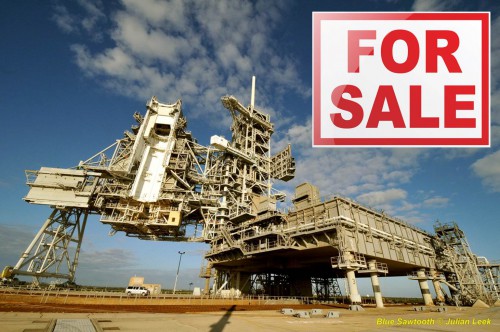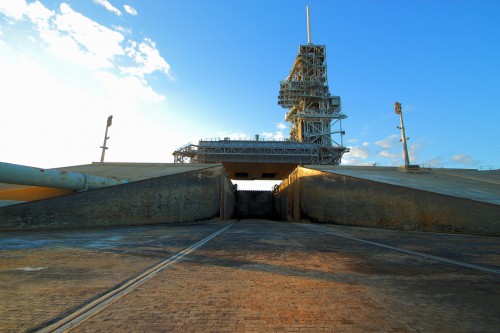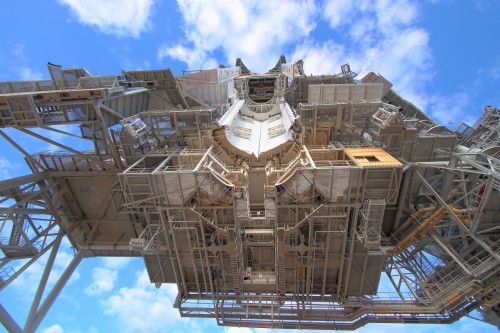
CAPE CANAVERAL, Fla — NASA is moving ahead with the space agency’s efforts to cede control of key structures and facilities as Kennedy Space Center in Florida. Through a synopsis released May 17, 2013, the agency plans to seek proposals for use of the historic location. NASA has said that it will be issued sometime next week.
Similar to how NASA has worked to empower private industry to handle delivering cargo and crew to the International Space Station, the agency has already attempted to lease use of Orbiter Processing Facility 3 (OPF-3). It was announced in 2011 that Boeing would take control of the structure and use it to process the company’s CST-100 spacecraft. As reported earlier, Boeing has yet to officially sign the lease.
NASA hopes that commercial companies will step up and utilize LC-39A to launch their spacecraft from.
LC-39A was the site where Apollo 11 thundered into the history books. Numerous other manned missions have had their start at LC-39A.

“We remain committed to right-sizing our portfolio by reducing the number of facilities that are underused, duplicative, or not required to support the Space Launch System and Orion,” said Kennedy Center Director and three-time shuttle veteran Bob Cabana. “Launch Complex 39A is not required to support our asteroid retrieval mission or our eventual missions to Mars. But it’s in the agency’s and our nation’s best interest in meeting our commitment and direction to enable commercial space operations and allow the aerospace industry to operate and maintain the pad and related facilities.”
To date, commercial companies have not launched any astronauts. Under the current time table, due primarily to budgetary issues, the first flight of commercial craft under NASA’s commercial crew program is not slated to begin until 2017.
Moreover, two of the companies vying to launch crews on their spacecraft, Sierra Nevada Corporation with its Dream Chaser space plane as well as Boeing, have stated that they plan to use United Launch Alliance’s Atlas V rocket to send their commercial spacecraft aloft. This would likely mean that CST-100 and Dream Chaser would launch from Space Launch Complex 41 located at the adjacent Cape Canaveral Air Force Station.
Given that the last participant under NASA’s Commercial Crew integrated Capability, or “CCiCap,” is SpaceX and would doubtlessly use Canaveral’s Space Launch Complex 40 to launch their Falcon 9 rocket and Dragon spacecraft from, it is not clear who would be interested in using LC-39A.

What might occur is that all of some of the firms involved with NASA’s commercial crew efforts could use LC-39A for this purpose (leaving SLC-40 and 41 for non human-rated launches). LC-39A could be used by companies not planning to launch crew or some mix of the two. The adjacent Launch Complex 39B has been renovated under the clean pad concept. This means that a variety of launch vehicles can use LC-39B as the launch structure, in most cases, travels with the rocket to the pad.
LC-39B is currently tasked as the launch site of NASA’s new heavy-lift booster, the Space Launch System (SLS), as well as the Orion Multi-Purpose Crew Vehicle that will be powered aloft by SLS.
This concept is nothing new as, during the Apollo era, the powerful Saturn V rocket used a somewhat similar design philosophy. Once the shuttle era began, both LC-39A and B underwent renovations that incorporated emplaced launch structures. Those on LC-39B have since been torn down; currently those on LC-39A are still intact.
To acquire LC-39A for launch activities, potential clients would need to assume financial and technical responsibility of the complex’s operations and management. NASA views a possible commercial customer as further strengthening the space agency’s efforts to encourage the commercial use of resources that the agency is not currently using.
The use of the words/imagery detailing that Launch Complex 39A is “for sale” or “for lease” are meant to highlight the transitional status of the structure.
Want to keep up-to-date with all things space? Be sure to “Like” AmericaSpace on Facebook and follow us on Twitter:@AmericaSpace




It certainly would be great to see LC-39A used again but SpaceX, Boeing, etc are going for much simpler pads on the Air Force side of the causeway. They some with less complications and easier access. For one thing, they could come with just the pad, as when SpaceX re-used an old Titan launch site. 39A still has a lot of Shuttle legacy stuff, and you have to drive way up the hill to get to it.
A great article & wonderful pics help to REMIND people that an HISTORICAL LEGACY REMAINS & must be dealt with RESPONSIBLY & CREATIVELY & not allowed to go to rust & ruin or…WORSE….to the “dust-bin” (CUT UP & SOLD FOR SCRAP!!) Thanks for making the situation PUBLIC….!!!! It’s a START!!!